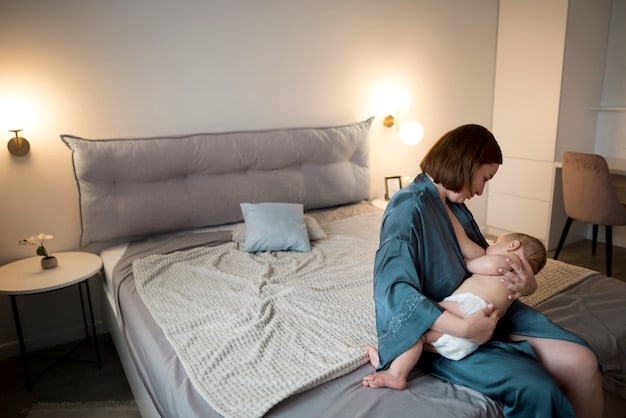Co-Sleeping Guidelines: What Parents in the US Need to Know

Recent Updates: New Guidelines on Co-Sleeping – What Parents Need to Know, providing information on how to create a safe sleep environment for infants and young children, addressing misconceptions and offering practical advice for families in the US.
Navigating the world of infant sleep can be overwhelming, especially with conflicting advice and evolving guidelines. Here’s what parents in the US need to know about the recent updates: new guidelines on co-sleeping – what parents need to know, ensuring the safety and well-being of your child.
Understanding the Basics of Co-Sleeping
Co-sleeping, or bed-sharing, is a practice where parents and their children sleep in close proximity. It’s crucial to understand the different forms it can take and the various viewpoints surrounding this sleep arrangement. This practice has cultural roots and is often chosen to promote bonding and facilitate breastfeeding.
While co-sleeping can offer benefits, it’s essential to distinguish between safe and unsafe practices. Understanding the risks and benefits can help parents make informed decisions aligning with their family values and circumstances.
What is Co-Sleeping?
Co-sleeping encompasses various sleeping arrangements, including:
- Bed-Sharing: Sleeping in the same bed with your child.
- Room-Sharing: Having the baby’s crib or bassinet in the same room as the parents.
- Co-Sleeping Devices: Using bedside sleepers or co-sleepers attached to the adult bed.
Benefits and Risks
Co-sleeping is a deeply personal choice, and it’s important to understand the pros and cons:
- Benefits: Enhanced bonding, easier breastfeeding, and improved sleep for some parents.
- Risks: Increased risk of SIDS (Sudden Infant Death Syndrome) under certain conditions, accidental suffocation, and overheating.
- Safe Practices: Following established guidelines to minimize risks.
It’s important to stay updated with evidence-based recommendations to prioritize your child’s safety.

Key Updates in Co-Sleeping Guidelines
Recent guidelines reflect the latest research and aim to provide parents with evidence-based recommendations. These updates often emphasize specific conditions under which co-sleeping is considered unsafe and offer practical tips for creating a safer sleep environment.
Changes in guidelines are driven by a continued effort to reduce the risk of SIDS and other sleep-related incidents. Healthcare organizations regularly review and update these guidelines.
Recommendations from Leading Organizations
Organizations like the American Academy of Pediatrics (AAP) and the World Health Organization (WHO) release guidelines focusing on:
- Infant Sleep Position: Always placing babies on their backs to sleep.
- Safe Sleep Surface: Using a firm mattress in a safety-approved crib or bassinet.
- Room-Sharing: Recommending room-sharing without bed-sharing for the first six months to a year.
Factors Influencing the Recommendations
Several factors influence these recommendations, including:
- Latest Research: New studies on SIDS and sleep-related incidents.
- Cultural Practices: Acknowledging diverse parenting practices.
- Individual Risk Factors: Considering factors like parental smoking, alcohol consumption, and drug use.
These guidelines aim to provide comprehensive advice adapting to different family situations.
Creating a Safe Co-Sleeping Environment
If you choose to co-sleep, it’s crucial to create a safe environment following established guidelines. This involves making changes to your sleeping arrangement and habits to minimize risks.
Implementing safety measures can significantly reduce the risk of SIDS and accidental suffocation, allowing for a potentially safer co-sleeping experience.
Essential Safety Measures
To ensure a safe co-sleeping environment, consider these measures:
- Firm Mattress: Use a firm, flat mattress with no gaps between the mattress and the bed frame.
- No Loose Bedding: Avoid pillows, blankets, comforters, and soft toys near the baby.
- Baby on Back: Always place the baby on their back to sleep.
Additional Tips for Safety
Here are some additional considerations:
- Avoid Overheating: Dress the baby in light clothing to prevent overheating.
- Non-Smoking Environment: Ensure a smoke-free environment, as smoking significantly increases the risk of SIDS.
- Sober Co-Sleeping: Avoid co-sleeping if you or your partner have consumed alcohol or drugs.
These measures create a safer sleep environment for your baby.

Addressing Misconceptions About Co-Sleeping
Co-sleeping is often surrounded by misconceptions that can lead to confusion and anxiety. It’s important to address these misconceptions to promote informed decision-making.
Clearing up these myths can help parents confidently navigate their co-sleeping choices while ensuring the safety of their child.
Common Myths and Facts
Let’s debunk some common misconceptions:
- Myth: Co-sleeping always leads to SIDS. Fact: When done safely, co-sleeping does not automatically lead to SIDS.
- Myth: Babies sleep better alone. Fact: Some babies sleep better when close to their parents.
- Myth: Co-sleeping is only for certain cultures. Fact: Co-sleeping is practiced in various cultures for different reasons.
The Role of Education and Awareness
Education and awareness are crucial for promoting safe co-sleeping practices:
- Stay Informed: Keep up with the latest guidelines and research.
- Consult Healthcare Providers: Discuss your co-sleeping plans with your pediatrician.
- Share Experiences: Connect with other parents to share tips and experiences.
Informed parents are better equipped to make safe choices for their families.
The Impact of Parental Habits on Co-Sleeping Safety
Parental habits significantly influence the safety of co-sleeping. Factors like smoking, alcohol consumption, and medication use can substantially increase the risks.
Understanding how these habits affect co-sleeping safety allows parents to make choices that protect their child’s well-being.
Smoking and Co-Sleeping
Smoking in the household poses significant risks:
- Increased SIDS Risk: Smoking greatly elevates the risk of SIDS, especially with co-sleeping.
- Secondhand Smoke Exposure: Infants are more vulnerable to the harmful effects of smoke.
- Recommendation: Avoid smoking altogether for a safer co-sleeping environment.
Alcohol and Medication
Substance use can impair judgment and reaction time:
- Impaired Awareness: Alcohol and drugs can reduce your awareness of the baby’s needs.
- Risk of Rolling Over: Parents might accidentally roll over on the baby.
- Recommendation: Avoid co-sleeping if you have consumed alcohol or medication that causes drowsiness.
Prioritizing your child’s safety requires a conscious effort to minimize these risks.
Individualized Approaches to Sleep Arrangements
Every family is different, and sleep arrangements should be tailored to individual needs and circumstances. There is no one-size-fits-all solution.
Considering your family’s unique dynamics allows you to create a sleep arrangement that promotes both safety and comfort.
Factors to Consider
When deciding on a sleep arrangement, consider:
- Parental Preferences: What feels most comfortable and convenient for you and your partner.
- Baby’s Temperament: Some babies thrive with close proximity, while others do better in their own space.
- Cultural Beliefs: Incorporate your cultural beliefs while ensuring safety.
Adjusting Over Time
Sleep arrangements may need to change as your child grows:
- Developmental Milestones: Adjust as your baby reaches new milestones.
- Changing Needs: Adapt to your child’s evolving sleep patterns.
- Flexibility: Be open to modifying your approach as needed.
Being flexible and responsive ensures that your sleep arrangement continues to meet your family’s needs.
| Key Aspect | Brief Description |
|---|---|
| 🚼 Safe Surface | Use a firm mattress with no loose bedding around the baby to prevent suffocation. |
| 🚭 Smoke-Free | Avoid smoking as it greatly increases the risk of SIDS during co-sleeping. |
| 😴 Sober Co-Sleeping | Do not co-sleep under the influence of alcohol or medications that cause drowsiness. |
| 🤱 Back Sleeping | Always place the baby on their back when sleeping to reduce the risk of SIDS. |
Frequently Asked Questions
▼
The latest guidelines often emphasize room-sharing without bed-sharing, particularly for the first six months. Always place the baby on their back, use a firm mattress, and avoid loose bedding to reduce the risk of SIDS.
▼
Co-sleeping can facilitate breastfeeding, but safety measures are crucial. Avoid co-sleeping if you smoke, consume alcohol, or have taken medications that cause drowsiness to ensure a safer environment.
▼
Parental smoking significantly increases the risk of SIDS during co-sleeping. It’s recommended to create a smoke-free environment to protect the baby. This includes avoiding secondhand smoke exposure.
▼
A firm, flat mattress with no gaps between the mattress and the bed frame is recommended for co-sleeping. This ensures a stable and safe surface, reducing the risk of suffocation for the infant.
▼
Regularly checking on your baby during co-sleeping is important. Monitor their breathing and position to ensure they are safe. This helps to maintain a watchful presence and respond promptly to any issues.
Conclusion
Staying informed about the latest co-sleeping guidelines, implementing safe practices, and tailoring sleep arrangements to your family’s needs are essential for ensuring the well-being of your child. By understanding the risks and benefits, parents can make informed decisions that prioritize safety while fostering a nurturing sleep environment.





